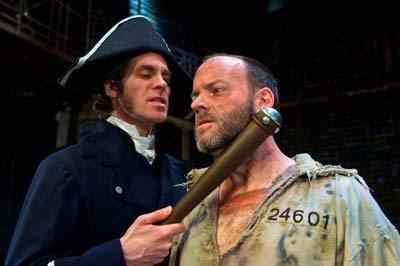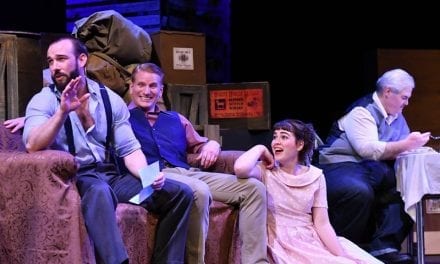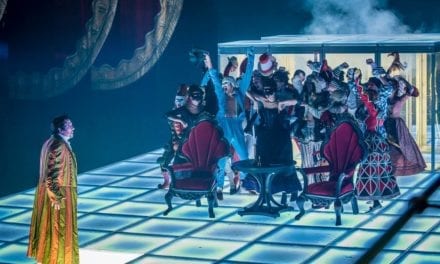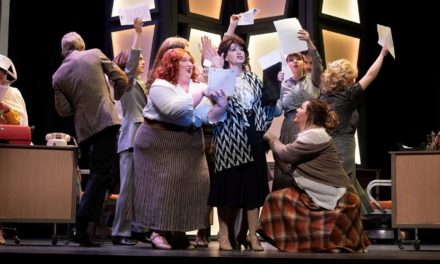SALT LAKE CITY – The songs and characters of Alain Boublil and Claude-Michel Schonberg’s Les Misérables are an underlying part of my life growing up. My family latched on to the tenth anniversary concert that played often on PBS stations, and we were awed at the powerful and beautiful stories portrayed in the songs. My sister started singing “Castle on a Cloud” around young Cosette’s age and soon grew into the other songs. I chose Gavroche as my pseudonym in high school French. The harrowing songs of lost love and lost lives are among the first to bring tears to my eyes.
Gladly, I left Pioneer Theatre Company’s latest production of this favorite musical reinforced with the beauty of the story on both the grand and intimate scale. The production faithfully adheres to the music and Jean Valjean’s story of redemption as he escapes his previous life as a thief and becomes an honest man. Charles Morey’s careful direction brought every element together flawlessly.
From the first hammer strokes of “Work Song” the mix of Morey’s direction, Karen Azenberg’s choreography, and Darren Cohen’s music direction blended seamlessly. I loved how Morey’s direction developed the world of the play. The ensemble moved through it naturally as they fought for entrance to the work house in “The End of the Day” and gathered around the student’s roused rhetoric asking them, “Do You Hear the People Sing?”. Each cast member took pains to create purpose for their character on the stage and yet focus each picture on the moment’s important character. Azenberg’s choreography beautifully embedded itself into hammer strokes, marches, prostitutes’ catcalls, and more so much that everyday actions developed into a simply beautiful dance following the epic music. Cohen directed the orchestra and ensemble with musical excellence and ensured that each voice was powerful and clear. The words were crisp and coherent, and I can’t think of a time I noticed a voice out of place.
The immense set created by George Maxwell filled the stage from top to bottom with its light brown brick walls, iron rails, and large wooden doors. The various stairwells, entrances, and the turntable created flawless transitions between in the fields, the church, and streets of a town. The set pieces and Morey’s blocking moved flawlessly from outside to inside the workhouse in only a few seconds. Thereafter, the set continuously moves the action from one moment to the next until the play ends.
Joe Cassidy as Jean Valjean took the world of Victor Hugo‘s novel and made it his own. Cassidy portrayed intimate moments in both his actions and his voice. His dramatic realizations and soft memories made as he touched the silver candlesticks or Cosette’s first doll made every line deeply felt. In Cassidy’s interpretation, Valjean progressed physically from the unbalanced escaped convict to the grounded and aging father. This allowed me to see the development from the stumbling in the first few soliloquys to the gentle pacing of his prayer in “Bring Him Home.” Cassidy’s voice was powerful and balanced from conversational moments to the connected, vibrant sounds of his falsetto.

Joe Cassidy (Valjean) surrounded by, L-R, Melissa Mitchell (Cosette), Manna Nichols (Eponine), Kelly McCormick (Fantine) and Perry Sherman (Marius). Photo by Alexander Weisman.
Josh Davis was an intimidating force as Valjean’s pursuer, Inspector Javert. He stalked about stage with the force of beast to be reckoned with. His voice equally matched that power, blaring with determination as he completed his own prayers in “Stars” and “Javert’s Suicide.” Davis grasped my attention so firmly that I could not imagine anyone’s view but Javert’s own being right. Kelly McCormick as Fantine radiated so much happiness as she sang “I Dreamed a Dream,” yet effectively transitioned to a startling dark face and voice in an instant as she told of her dream shattering. My favorite moment from her was her touching vision of Cosette playing even as sickness has almost driven her mad. I could almost see the little girl playing her mind’s eye.

Joe Cassidy (Valjean) surrounded by, L-R, Melissa Mitchell (Cosette), Manna Nichols (Eponine), Kelly McCormick (Fantine) and Perry Sherman (Marius). Photo by Alexander Weisman.
Manna Nichols showed much of the same hope in Eponine as she dreamed of walking with Marius in “On My Own” and enjoyed some dreams come true in “A Little Fall of Rain.” But her strong voice also broke my heart as her daydream dance stopped and she realized “all [her] life [she’s] only been pretending.” As the girl masquerading in boy’s clothes died in the arms of her love, trying so hard to be brave, I could sense the fear of death in the shaking of Nichols’s voice and her clench on Marius’s arm. Perry Sherman as Marius and Melissa Mitchell as Cosette embodied the couple torn by the events of the revolution, but I loved the characterizations outside of their love story that the actors introduced. Cosette was so anxious for understanding that she berated Valjean for the truth, but then was equally anxious to be with Marius. Meanwhile, Sherman portrayed Marius as a vibrant and impetuous youth who slowly understood the consequences to his actions. The way he so despairingly shook his head as he held Eponine during her last breath, or reminisced during “Empty Chairs at Empty Tables” gives a hint of his growing comprehension of life’s complexity.
In contrast, Christianne Tisdale and Dale Hensley masterfully showed the purposefully villainous and worldly Thénardiers. Their delightfully awkward or viscous attitudes ran them from one scam to another in “Master of the House” until ending with their final romp throwing the wedding into disarray during “Beggars at the Feast.”
When I saw the recently released movie of Les Mis I asked my brother what he thought. He told me that while the film was also very good, “some things are just more powerful on a darkened stage.” As the final rousing chorus of “Do You Hear the People Sing” finished, I joined the other audience members in giving a standing ovation because this cast and crew had proved my brother right. This beautiful production exceeded my expectations with its strong voices and powerful emotions of love and the hope that comes as we hold on to our dreams for “One Day More.”








